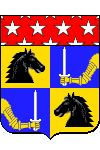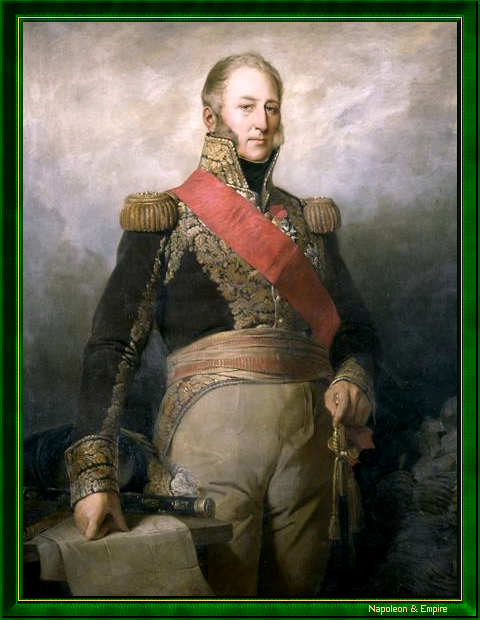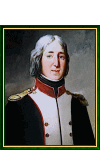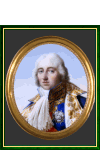Adolphe Édouard Casimir Joseph Mortier
First Duke of Treviso
Pronunciation:

Born on February 13, 1768 at Cateau-Cambrésis in northern France, the son of a cloth merchant who was a member of the Constituent Assembly, young Edouard Casimir Mortier joined the National Guard after a solid education, and was elected captain of the 1st Battalion of Northern Volunteers in September 1791.
Although he took part in all the major battles - Jemmapes, Hondschoote, Fleurus, siege of Maastricht with the Army of the North; Altenkirchen, Giessen, Friedberg, occupation of Mainz with the Army of the Rhine - his career, especially when compared with that of some of his future colleagues, was not particularly brilliant.
He did not become a brigadier general until February 1799 (after having refused the rank for the first time in 1797, at the time of the peace of Campo-Formio). Mortier proved so useful to André Masséna during the campaign against the Austro-Russians that he was appointed divisional on the battlefield of Zurich on September 25.
Having wholeheartedly supported the coup d'état of 18 Brumaire, he was placed in a position of trust: command of the 17th military division, headquartered in Paris. He remained there for three years, earning Napoleon Bonaparte's esteem for his composure, diligence and perfect execution of orders.
After the Peace of Amiens broke down in May 1803, the First Consul commissioned him to occupy the electorate of Hanover. Less than a month later, his mission was accomplished, the enemy army had surrendered and Mortier had begun to organize the country in the French style, taking care not to inflict unnecessary hardship on the population.
On his return, he was appointed colonel general commanding the artillery and sailors of the consular guard, then marshal (May 1804).
In 1805, he commanded the Guard infantry. In 1806, he once again occupied the electorate of Hanover - which had in the meantime been ceded to Prussia - and the rest of northern Germany. He had to implement the draconian measures decided by Napoleon I, particularly against the English who had settled in the region, but he refused to break into the counters of the Hamburg bank. (Seven years later, Louis-Nicolas Davout would be less scrupulous). He then led the left wing at Friedland and became governor of Silesia after the Peace of Tilsit.
He spent a year in this post, then three in Spain after being created Duke of Treviso (July 1808). He took part in the battles of Licinena and the Arzobispo bridge (August 8, 1809), was wounded at the battle of Ocaña (November 19), and fought again at Fuentes de Cantos (September 15, 1810) and La Gebora (February 19, 1811).
During the Russian campaign, Mortier commanded the young guard, taking part in the battles of Borodino (September 7, 1812), Krasnoye and Berezina (November 17-18). As governor of the Kremlin, he was responsible for blowing up the Tsar's palace after Napoleon I's departure. This order was never carried out.
Present at all the battles of the campaign in Saxony of 1813, he took part in the campaign of Northeast France in 1814 at the head of the Old Guard. Charged, with Auguste Viesse de Marmont, with defending Paris, and seeing his troops pushed back as far as the barrière de la Villette, he agreed with his colleague to negotiate a ceasefire, then withdrew with his soldiers to Corbeil to await the outcome of events without compromising himself. On April 8, he supported Napoleon I's deposition, then submitted to Louis XVIII, who appointed him governor of Lille.
In March 1815, when the fugitive king wanted to settle in Lille, Mortier urged him not to consider it, as the city was unsafe. His advice having been heeded, the Marshal left for Paris to resume his position with the Emperor. The Emperor appointed him Commander-in-Chief of the Imperial Guard. Mortier entered the campaign on June 8, but gave up his command on June 13, two days before the battle of Waterloo, due to an attack of gout that left him bedridden.
The Second Restoration showed little resentment at first, and made him military governor of Rouen. But when the council of war appointed to judge Michel Ney, of which he was a member, declared itself incompetent, Mortier was finally disgraced.
He was elected to the Chamber of Deputies in 1816, and regained his peerage in 1819. Under Louis-Philippe, whom he had met in his youth in the northern army, he was successively ambassador to Russia from December 1830 to September 1831, then Minister of War and President of the Council from November 18, 1834 to March 12, 1835.
He died on July 28, 1835, killed by Giuseppe Fieschi's infernal machine during a review of the National Guard.
"Marshal Mortier, Duke of Treviso". 19th century French school.

Mortier's name is inscribed on the 13th column (east pillar) of the Arc de Triomphe de l'Etoile .
His tomb is in Paris, in the Père Lachaise cemetery, division 27. His heart still rests there, while his remains have been transferred to the Invalides .
Freemasonry : Initiated in February 1792 into the lodge "Les Amis Réunis" of Lille, honorary member of the regimental lodge "Les Emules d'Assas", Marshal Mortier was named Grand Officer of the Grand Orient of France in 1806 and then became, under the Restoration, a member of the Supreme Council of the 33rd degree.Detailed military career
Established by Mr. Eric Le Maître, posted online with his kind permission.Wounded in action
By a shot from a grapeshot at Dourlers, on October 15, 1793.Wounded at Ocaña, November 19, 1809.
Captivity
NoneFirst engagement
In the National Guard of Dunkirk, in 1789.Career development
Captain, September 1, 1791.Adjutant general, battalion commander, September 3, 1793.
Adjutant general, brigade commander, June 13, 1795.
Brigadier General, February 23, 1799.
Provisional Major General, September 25, 1799, confirmed October 19, 1799.
Marshal of the Empire, May 19, 1804.
Service record
In the National Guard of Dunkirk, between 1789 and 1791.1st Battalion of Nord Volunteers, September 1, 1791.
Chief of staff of the Balland division, October 1793.
Sambre-et-Meuse army, between 1794 and 1797.
23rd Cavalry, January 16, 1797.
Chief of staff to Lefebvre in the Mainz army, 1798.
Brigadier general in the army of Mainz and then of the Danube, February 23, 1799.
To the Lefebvre division, March 25, 1799. Legrand division, April 30, 1799.
Soult division, June 1799.
Commanded the 4th division, August 28, 1799.
Commanded the 3rd division, October 3, 1799.
Commanded the 2nd division of the Army of the Rhine under Lecourbe, December 11, 1799.
Commander of the 17th military division in Paris, April 15, 1800.
Superior commander of the 15th and 17th military divisions, then of the 17th (which became the 1st military division on January 21, 1801), April 21, 1801.
Commanded the army corps occupying Hanover, from May 3, 1803 to May 14, 1804.
Colonel-general commanding the artillery and seamen of the Consular (then Imperial) Guard.
Commanded the infantry guard of the Grande Armée, August 30, 1805.
Commanded a provisional army corps in Austria, from November 7 to December 16, 1805.
Commanded the 5th corps of the Grande Armée in place of Lannes, December 9, 1805.
Commanded the 8th corps of the Grande Armée, October 1, 1806.
Commander of the 5th and 6th Corps and Governor of Silesia, July 12, 1807.
Commander of the 5th Corps of the Spanish Army, October 2, 1808.
Recalled to France, May 1811.
Commander-in-chief of the young guard in the Grande Armée, June 20, 1812.
Governor of Moscow, September 14, 1812.
Commander of the Imperial Guard in the Grande Armée under Prince Eugène de Beauharnais, January 22, 1813.
Commander of the Imperial Guard, November 22, 1813.
Commanded the Old Guard from December 1813 to April 1814.
Placed himself under Marmont's orders to defend Paris; defeated at La Villette, March 30, 1814; signed the capitulation and withdrew to Fontainebleau.
Peer of France at the First Restoration, June 4, 1814.
Governor of the 16th military division in Lille, June 21, 1814.
Peer of France during the Hundred Days, June 2, 1815.
On extraordinary mission to inspect the border from Calais to Landau, April 30, 1815.
Commander of the Imperial Guard, June 8, 1815.
Fell ill at Beaumont and did not serve in Belgium.
Struck off the Pairie, July 24, 1815.
Governor of the 15th military division in Rouen, January 10, 1816.
Elected deputy of the Grand College du Nord, October 4, 1816.
Peer of France, March 5, 1819.
Member of the High Council of War, February 1, 1828.
Governor of the 14th military division in Rouen, July 19, 1829.
Ambassador to Russia, December 6, 1830.
Grand Chancellor of the Legion of Honor, September 11, 1831.
Ambassador to Russia again, February 22, 1832.
Minister of War and President of the Council, November 18, 1834.
Resigned, March 12, 1835.
Chancellor of the Legion of Honor, March 12, 1835.
Other portraits

"Adolphe Edouard Casimir Joseph Mortier, captain in the 1st Northern Battalion in 1792" by Charles-Philippe Larivière (Paris 1798 - Paris 1876).

"Marshal Mortier, Duke of Treviso". Thumbnail by Jean-Baptiste Isabey (Nancy 1767 - Paris 1855) decorating the top of the Table d'Austerlitz (also known as the Table of Marshals)